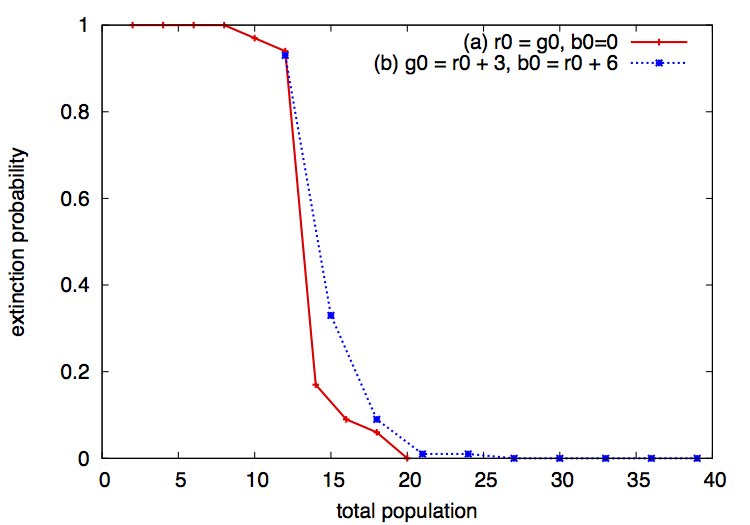| [top] | [up] | [previous] | [next] |
![]()

As stated by Winkler in [Winkler2009b], after each iteration of the Chameleons chemistry, the difference between the number of chameleons of each color remains the same or changes by 3. Hence the difference stays the same modulo 3. It follows that when the difference between two colors is not zero or a multiple of 3, it will never reach zero, since the difference modulo 3 remains unchanged.
Conversely, when the difference between the number of chameleons of two different colors is a multiple of 3, there is the possibility that this difference becomes zero, and that these two populations change to the 3rd color, leading to a configuration where all the chameleons have the same color. When this configuration is reached, no more reactions can take place and the system becomes inert.
In practice this outcome is rare, because it not only requires the modulo 3 difference condition above to hold, but also requires a contingency of "bad luck" circumstances that lead to the extinction of two colors in favor of a 3rd one. This is illustrated in figure 2 of the Chameleons tutorial, where although we start with the same number of red and green chameleons (hence satisfying the modulo 3 condition), none of the populations go extinct, and even if we repeat the run several times, it is unlikely that we will observe any extinction event.
On the other hand, it is obvious that if we start with only one red and one green individual, after only one iteration the system becomes inert. In order to measure the probability of extinction as a function of the initial population numbers, I modified the Chameleons.py example to start with various combinations of red, green and blue chameleons, ran each configuration 100 times to take contingency into account, and counted the number of runs that became inert before 10000 iterations. This is the result I obtained:

We can see that the probability of observing an extinction event (within the 10K iteration window of our experiment) drops sharply with the population size. This explains why it would be very hard to observe an extinction using the configuration of figure 2 where the population size is pretty large.
![]()
Last updated: September 19, 2015, by Lidia Yamamoto